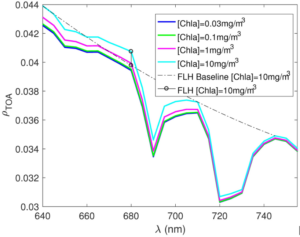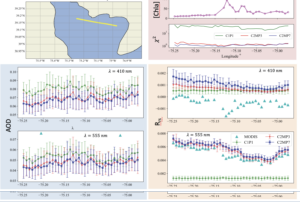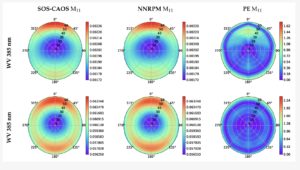Light Scattering



Light scattering theory describes the angular distribution of scattered radiation upon interaction with a particle. The angular pattern and polarization properties resultant from the light scattering theory are important in interpreting lidar measurements and passive imageries. For simple cases involving spherical particles or particle size much smaller than the light wavelength, there exist analytical solutions. However, people have to rely on numerical models to understand how a general non-spherical particle scatters light. One important aspect of our research is to:
1. Develop numerical models which can solve light scattering by general non-spherical particles.
2. Using existing numerical tools to understand the intensity and polarization properties of the scattered light due to non-spherical aerosols and hydrosols.
One example is shown above, in which we have constructed an realistic three dimensional non-spherical model for Emiliania huxleyi (EHUX), a species of coccolithophore found in almost all ocean ecosystems the equator to sub-polar regions. We studied the Scanning Electron Microscope images of EHUX, and constructed a digital model of detached EHUX coccolith (left image). The detached model is then duplicated and grouped together to construct a symmetrical model for the whole coccolithophore (middle). Studies show that many EHUX cells have certain degree of randomness and non spherical aspect ratio, which leads to the third model (right). These digital models can be used by numerical light scattering model to mimic the light scattering pattern of true EHUX cells. For details, please refer to our paper published in Optics Express:
Radiative Transfer

Radiative transfer theory describes light multiply scattered in a turbid medium. Radiative transfer for the coupled atmosphere and ocean system (CAOS) is a special branch that is important for characterizing the aerosol and ocean color information for the Earth system. Historically, many approximations have been used in the radiative transfer solutions for CAOS for the sake of simplicity. Among them is the scalar approximation, which neglects the polarization property of light. An even more widely used approximation is to ignore inelastic scattering, in which a fraction of electromagnetic energy is scattered into different wavelengths. The main inelastic scattering mechanisms in ocean waters include Raman scattering by water molecules, fluorescence by dissolved organic matters, and fluorescence by chlorophyll a in phytoplankton particles.
The inelastic processes contribute significantly to the light field exiting the ocean system and contain important information on ocean constituents. I have developed a radiative transfer model that rigorously accounts for atmosphere and ocean interaction, light polarization, and both the elastic and inelastic scattering in ocean waters. This computer model is the first of its kind in the radiative transfer community that uniquely solves all physics process that can be used to fully explore the capability of future satellite measurements. A series of peer-reviewed papers have been published on different theoretical and computational aspects of this model in Optics Express. Furthermore, this computer model has been used to support NASA’s Plankton, Aerosol, Cloud, and ocean Ecosystem (PACE) mission, which is designed to take measurements of the Earth system with unprecedented spectral coverage.
Aerosol and Ocean Color Retrieval Using Polarimeter Data

The total light signal measured at the top of the atmosphere includes contributions from both the atmosphere and ocean. The basic principle of remote sensing of the environment is to quantify, decompose, and attribute the signal to different components. In the context of ocean color remote sensing, this procedure is collectively called atmospheric correction. Traditional atmospheric correction algorithms work well for scenes above open ocean waters, where the optical properties of aerosols and ocean waters are well known and constrained. However, atmospheric correction in scenes involving coastal waters remains a challenging task, where both aerosol and water properties are poorly understood. In order to understand the ecosystem and better characterize the primary productivity in coastal waters, more advanced measurements and better retrieval algorithms need to be developed for separating atmosphere and ocean contributions.

NASA’s PACE mission plans to include polarimeters that could view the Earth at multiple viewing angle, with multiple polarization, and at multiple important wavelength bands. One of the PACE polarimeters is called Hyper-Angular Rainbow Polarimeter (HARP-2), contributed by Prof. Vanderlei Martins from UMBC. The new polarimeter measurements will provide a plethora of additional information, which needs to be extracted by complicated and special algorithms. This is currently a research frontier and there are only several groups in the international remote sensing community that have demonstrated the effective use of the polarimeter data for aerosol, cloud, and ocean color information determination.
My group has developed a retrieval algorithm that performs the least squares fitting of the polarimeter data with theoretical predictions. To date my retrieval algorithm is the only one that demonstrated accurate determination of ocean color information over coastal waters, which has far-reaching application in the PACE science. Our paper on this subject is published in Optics Express.
Ocean Water Reflectance Characterization
 In the ocean color retrieval using polarimeter data, the ocean radiative transfer calculation is computationally intensive, which made it difficult to develop an operational near real-time algorithm for satellite data products. One way to work around this problem is to develop an approximate semi-analytical solution constrained by pre-built radiative transfer simulations. The semi-analytical solution is useful for efficient yet accurate determination of ocean reflectance, with the error range well specified. My group is interested in investigating light scattering properties of particles in ocean waters. We have developed a new semi-analytical model for ocean reflectance in the visible to near infrared spectral range. This work will simplify the radiative transfer simulation and facilitate the interpretation of both in situ and remotely measured polarimetric and radiometric signals of ocean waters.
In the ocean color retrieval using polarimeter data, the ocean radiative transfer calculation is computationally intensive, which made it difficult to develop an operational near real-time algorithm for satellite data products. One way to work around this problem is to develop an approximate semi-analytical solution constrained by pre-built radiative transfer simulations. The semi-analytical solution is useful for efficient yet accurate determination of ocean reflectance, with the error range well specified. My group is interested in investigating light scattering properties of particles in ocean waters. We have developed a new semi-analytical model for ocean reflectance in the visible to near infrared spectral range. This work will simplify the radiative transfer simulation and facilitate the interpretation of both in situ and remotely measured polarimetric and radiometric signals of ocean waters.
Aerosol Absorption Characterization Using Hyperspectral Radiometric Data
Aerosols play vital roles in the global climate system. Light in the atmosphere can be either scattered or absorbed by particles. The amount of aerosol absorption directly affects the energy balance of the Earth system, which is poorly understood and is among the greatest sources of uncertainty in the Earth’s complex climate system. Numerous efforts have been made to reduce the aerosol absorption uncertainty with limited success. We have proposed to tackle this problem by retrieving aerosol absorption property using hyperspectral radiometry in combining with space lidar measurements. This is directly applicable to NASA’s Orbiting Carbon Observatory (OCO-2) and Cloud-Aerosol Lidar and Infrared Pathfinder Satellite Observation (CALIPSO) missions, which makes close measurements of the Earth system. We have received research grants from the OCO-2 science team to perform this research. Once developed this algorithm will produce global aerosol absorption properties that help reduce the energy balance uncertainty greatly.
Research Summary and Future Opportunities
In summary, my research interest is to elucidate fundamental theories of light scattering, radiative transfer, and remote sensing of aerosols and ocean color. Light scattering deals with the interaction of electromagnetic wave with a single particle. Single scattering properties of particles can be directly used by lidar techniques to remotely detect and characterize aerosols, clouds, and hydrosols. They are also used as inputs to radiative transfer, which solves the propagation of electromagnetic radiation multiply scattered in turbid media. The research findings of light scattering and radiative transfer can be applied to remote sensing of aerosols and ocean color with different types of measurements, including lidar, hyperspectral radiometer, and polarimeter.
My research effort is directly applicable to current and future NASA missions, including PACE, OCO-2, and CALIPSO. In addition, NASA is planning several new decadal missions, which aim to characterize the atmosphere, land, and ocean system. Among them are the Surface Biology and Geology mission which will carry a hyperspectral imager in the visible and shortwave infrared; and the Atmosphere Observing System (AOS) mission which will include new lidar, radar, and polarimeter instruments (https://science.nasa.gov/earth-science/decadal-surveys/decadal-survey-questions). My research is well suited to help develop new remote sensing algorithms for these new instruments and further explore new science questions related to these missions.